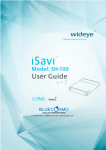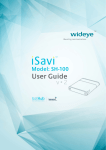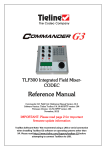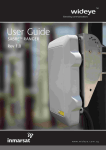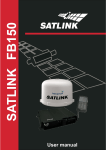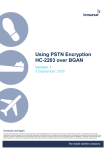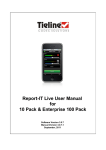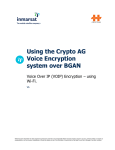Download Extra long document title goes here
Transcript
Using Tieline Codecs over BGAN Version 01 08.10.09 inmarsat.com Whilst the information has been prepared by Inmarsat in good faith, and all reasonable efforts have been made to ensure its accuracy, Inmarsat makes no warranty or representation as to the accuracy, completeness or fitness for purpose or use of the information. Inmarsat shall not be liable for any loss or damage of any kind, including indirect or consequential loss, arising from use of the information and all warranties and conditions, whether express or implied by statute, common law or otherwise, are hereby excluded to the extent permitted by English law. INMARSAT is a trademark of the International Mobile Satellite Organisation, Inmarsat LOGO is a trademark of Inmarsat (IP) Company Limited. Both trademarks are licensed to Inmarsat Global Limited. © Inmarsat Global Limited 2009. All rights reserved. Contents 1 Overview 1 2 Key features 1 3 Benefits to BGAN users 2 4 Typical users 2 5 Setting up Tieline for ISDN broadcasting 2 5.1 Equipment needed 2 5.2 Setting up the BGAN terminal 2 5.3 Setting up the Codec to Connect over ISDN using BGAN 3 5.4 Dialing from an Inmarsat terminal 4 5.5 Dialing into a BGAN terminal 4 5.6 Tieline Codec configuration 4 5.7 ISDN hints and tips 4 6 7 Setting up for Tieline IP broadcasting over BGAN 5 6.1 Equipment needed 5 6.2 Setting up for the Thrane & Thrane EXPLORER BGAN terminals 5 6.3 Connecting to BGAN 10 6.4 Setting up the Wideye SABRE BGAN terminal 11 6.5 Setting up the Hughes 9201 BGAN terminal 13 6.6 Setting up the Codec to Connect over IP using BGAN 14 6.7 Changing Codec Frames per packet (bundling) 14 6.8 Dialing from the BGAN-connected Codec 15 6.9 IP hints and tips 15 Further details and support 15 Tieline i-Mix G3 1 Tieline Commander G3 Overview Tieline i-Mix G3 or Commander G3 audio codecs are able to stream live bidirectional FM quality mono and stereo audio from any location. Tieline’s unique solutions include: • Live broadcast quality mono or stereo FM quality audio using 64Kbps BGAN ISDN connections. • Live broadcast quality mono FM audio using 32Kbps BGAN IP connections. Tieline’s IP solutions feature QoS Performance Engine technology for reliably managing connections over unreliable IP networks, like the Internet. It includes features such as Forward Error Correction (FEC) and automated jitter buffering for demanding IP broadcast situations. Tieline codecs can connect over a variety of connection transports through the use of interchangeable connection modules for ISDN. IP connections can be created by using the LAN port available on all Tieline codecs and no extra hardware is required. 2 Key features Tieline ISDN offers the following connections over the BGAN network: • Up to 20 kHz quality bidirectional mono audio connections using Tieline Music or Tieline MusicPLUS algorithms. • Up to 20 kHz quality bidirectional stereo audio connections using Tieline Music. • Up to 7.5 kHz quality bidirectional mono audio connections using the industry standard G.722 algorithm or Tieline Voice G3 algorithm. • Up to 3 kHz quality bidirectional mono audio connections using the industry standard G.711 algorithm. Tieline IP offers the following over the BGAN network: • Up to 15 kHz quality bidirectional mono audio using the Tieline Music algorithm. • Up to 7.5 kHz quality bidirectional mono audio connections using the Tieline Voice G3 algorithm. Using Tieline Codecs over BGAN 1 3 Benefits to BGAN users Tieline BGAN connections offer a number of benefits to broadcasters including: 4 • The ability to connect reliably and affordably, and broadcast live FM quality audio from remote locations. • The flexibility to connect using either IP or ISDN connections, depending on the broadcast situation and available connection bandwidth. • The ability to send high quality audio from a remote broadcast site and receive audio from the studio over the same connection. Typical users • 5 Broadcasters performing broadcasts from remote locations and wanting to send and receive live broadcast quality mono or stereo FM audio between the remote site and studio. Setting up Tieline for ISDN broadcasting This section describes how to set up BGAN for use with Tieline codecs and gives an example of an ISDN broadcast configuration. 5.1 Equipment needed • Tieline codec at the remote broadcast location connected to a BGAN terminal. • Tieline codec at the studio connected to an ISDN B channel. • PC for programming the BGAN connection and monitoring the codec connection. • ISDN grade cable with RJ-45 connectors on both ends. Tieline recommends connecting between the RJ-45 connector on a BGAN with an ISDN port like the Hughes 9201 or the Thrane & Thrane EXPLORER 700 terminal and a Tieline ISDN module (for ISDN connections). You can also use the vehicular terminals, such as the Hughes 9250 and the Thrane & Thrane EXPLORER 727. Some terminals, such as the Thrane & Thrane EXPLORER 500, have ISDN via USB, which is NOT compatible with Tieline codecs. Important note: Please ensure that your Inmarsat service supports 64Kbps UDI (Unrestricted Digital Information). Make sure that the terminal settings are set for 64Kbps UDI operation and that the SIM is enabled for Data. If the service is RDI, only lower quality voice connections are supported (i.e. G.711 algorithm). 5.2 Setting up the BGAN terminal To set up the BGAN terminal: a. Open the BGAN terminal and position the face of the satellite toward the sky. b. Using the compass on the back, point the antenna in the direction of the BGAN Satellite (in the US, this is the southern sky). Large trees or buildings obstructing the line of site may cause a weak signal or no signal at all. c. Turn power on by hitting the small grey “On” button towards the back and underneath. d. On the display screen you will be prompted to “ENTER PIN”. Just wait or press Cancel. Using Tieline Codecs over BGAN 2 Tips for obtaining a good signal a. Begin moving the BGAN terminal left to right by slowly moving the base. Try to obtain the highest signal strength possible. When beeping becomes more frequent and the strongest possible signal has been obtained, proceed with next step. b. On your display screen you will see your signal strength. Keep adjusting the angle to reach the peak signal strength. The ideal signal should be at, or higher than, 54.0 and the beeps become a steady long beep. (Note: Sometimes a signal strength of around 48dBHz will be satisfactory). c. Repeat these steps until maximum strength is reached. At this point you can hit OK on the display. It will go through a Registering mode; then Ready will be displayed. 5.3 Setting up the Codec to Connect over ISDN using BGAN First, set up your Tieline codec for the desired audio input level for CH1 and/or CH2. To do this: a. Go to SOFTKEY 1 AUD and select “Input Gains” by pressing any white “softkey” button. b. Next select “All Inputs” or “Input 1” and/or “Input 2” on Commander codecs (Inputs 3, 4 and 5 are also available on an i-Mix). c. Select the desired input level. We suggest “Med Gain” for headset/boom mic combinations, “High Gain” for ‘stick’ type mics, “Unbalanced” for consumer playback products such as iPods, MP3 Players, MiniDisc, CD players, etc. and “Balanced” for professional balanced audio devices. Second, attach your mic, headphone(s) and Tieline power supply to the codec and install a Tieline Euro ISDN module. Note: If your Euro module is not installed, always disconnect power when installing or swapping modules. Third, plug a Cat5/LAN cable into your Euro ISDN module and plug the other end into the “ISDN 1 or 2” input on the side of the BGAN. Now power up your codec and before dialing ensure the following codec ISDN settings are programmed: Scroll down until the square brackets surround “ISDN 1” on the main codec connection screen. Press the “Wiz” softkey to enter the codec ISDN Wizard and press “OK” to proceed. Then select: a. [Network; ÆEU-ETSIÅ] b. [Algorithm; ÆG.711 (voice), G.722, MP2, Voice G3, Music, MusicPLUS Å] c. [ISDN Line Type ; ÆP-MultiÅ] d. [Local Subaddress noneÅ] e. [SPID 1; ÆnoneÅ] f. [DN1; ÆnoneÅ] g. [SPID 2; ÆnoneÅ] h. [DN2; ÆnoneÅ] i. [Auto Reconnect; ÆDisableÅ] j. Select “OK” to return to the main connection screen. Note: It will take a moment for the codec to reset. When the display for ISDN 1 & 2 changes to “Enter # Sync”, it is ready to dial. Using Tieline Codecs over BGAN 3 5.4 Dialing from an Inmarsat terminal To dial out from your Inmarsat terminal: a. Check that you have a signal from the satellite. b. Dial the country code, area code and number. The ISDN connection will take a moment or two to connect. 5.5 Dialing into a BGAN terminal To dial into an Inmarsat terminal: a. Dial the IDD prefix (the international prefix needed to dial from the country you are in to another country). b. Dial the Inmarsat code 870 (like the Country Code when dialing between different countries). c. Dial the mobile number for the Inmarsat terminal. 5.6 Tieline Codec configuration 5.7 ISDN hints and tips The following are best practice hints and tips to ensure you get the most from Tieline codec when broadcasting over BGAN ISDN connections: • Ensure your Tieline codecs are all running codec firmware v.1.6.xx. • Test your connection well before the broadcast to ensure all your settings are correct. Using Tieline Codecs over BGAN 4 6 Setting up for Tieline IP broadcasting over BGAN This section describes how to set up BGAN for use with Tieline codecs over IP. Both 32Kbps and 64Kbps BGAN IP data connections provide 15 - 20kHz audio, depending on the available bit rate of the connection. Note: 6.1 Set up your BGAN terminal in the same way as you would for an ISDN connection (See the previous section titled “Setting up the BGAN Terminal” and “Tips for Obtaining a Healthy Signal.”). Equipment needed • Codec firmware version 1.6.50 or higher is required for 32Kbps BGAN connections to support bundling of multiple frames per IP packet. • A Tieline codec at the remote broadcast location connected to a BGAN terminal. • A Tieline codec at the studio connected to a broadband IP connection (DSL/ADSL/Cable), preferably programmed with a Public Static IP address, so that the remote codec can dial it directly. • A PC for programming the BGAN connection and monitoring the codec connection. • A LAN cable. Tieline recommends connecting between the LAN connection on a compatible BGAN terminal and the LAN port on a Tieline codec (for IP connections). By default, Tieline IP codecs are programmed to connect over IP using the Tieline Music algorithm, which provides up to 15 kHz mono audio quality at 24kbps. Tieline codecs are capable of connecting at either 64 Kbps or 32Kbps on BGAN connections. Connecting over 32Kbps connections reduces data use and lowers IP data costs substantially. Important Note: Select the relevant 32Kbps or 64Kbps streaming profile on the BGAN terminal to suit your connection. This should be programmed using either a web server interface or the LCD interface on the terminal itself. 6.2 Setting up for the Thrane & Thrane EXPLORER BGAN terminals A 32 kbps Streaming service should be initiated from the BGAN terminal and can be configured from either the EXPLORER’s built-in web server (via a laptop’s web browser) or using the LCD MMI. a. Open your internet web browser and type the following IP address in the address bar: 192.168.0.1 b. Click on Settings and then LAN. Now you should see the web server interface. c. The screenshot below shows the settings required as configured via the EXPLORER’s web server interface, ensure you click apply before leave the web page. Please consult your EXPLORER manual for more detailed information. Using Tieline Codecs over BGAN 5 Now your terminal is configured to start a Streaming 32 kbps connection after you register on the network. d. Restart your terminal and click OK after properly pointing the terminal. Once the Explorer is register on the BGAN network you will be connected automatically with a 32 kbps streaming connection. Connecting to the EXPLORER terminal via LCD MMI For security reasons, Streaming needs to be started manually. This is to ensure that per minute charges do not inadvertently accrue when the EXPLORER™ is turned on. This allows the user to more carefully monitor usage and connection time. The screenshot below shows the settings required as configured via the EXPLORER LCD MMI. Using Tieline Codecs over BGAN 6 To initiate a connection from the LCD MMI: a. Go to the main view of the LCD. b. Press the Arrow Down button until the CONNECT menu is selected c. Press OK d. Select Streaming 32 and press OK button e. Select START and press the OK button f. Press the OK button to confirm the 32 kbps Streaming connection and wait a minute or two to allow the EXPLORER to register the Packet Switched connection with the BGAN system. After registration the LCD main screen will show DATA ACTIVE. Using Tieline Codecs over BGAN 7 Connecting to the EXPLORER 500 BGAN terminal from the web server The 32 kbps Streaming service can started from the built-in Web Server of the EXPLORER 500 by pressing the “Start Streaming 32” link in the bottom of the page. See the screenshot below. To confirm to start the 32 kbps streaming press OK on the following pop up window After a few minutes, the information under ONGOING DATA SESSIONS in the built-in Web Server will show that the 32 kbps Streaming connection has been established. Please be aware that the web page needs to be refreshed manually using the Refresh button on the page or by using the web browser’s “Refresh” function. Connecting to the EXPLORER 110 via LCD MMI A 32 kbps Streaming service should be initiated from the BGAN terminal and needs to be configured from the EXPLORER 110’s built-in web server (via a PC’s web browser). a. Open your internet web browser and type the following IP address in the address bar: 192.168.0.1 Now you should see the web server interface. b. The screenshot below shows the settings required as configured via the EXPLORER 110’s web server interface. Please consult your EXPLORER 110 manual for more detailed information. Using Tieline Codecs over BGAN 8 c. Next, click on Data connections on the left hand menu. The following screen displays: d. Change the connection type by clicking the drop down box and select ‘Streaming 32 kbps’. e. Make sure your Data Connection Activation is set to ‘Automatic when any PC is connected to the Unit. f. Before you exit the web interface make sure you click ‘Store Settings’. Using Tieline Codecs over BGAN 9 6.3 Connecting to Explorer 110 You can connect to BGAN in two different ways, from the web server interface or by using the front panel. Using the front panel a. Power on the terminal by pressing and holding the ACTIVATE for 1.5 seconds. b. Obtain a GPS fix. c. Find the best signal. d. Press the Activate on the front panel of the terminal and you will automatically register to the network. Wait approx. 30 seconds and you will be on the internet. If you have a World Set you will see displayed ‘Connected’. Using the Web interface (if you set up ‘Data connection Activation’ to ‘Manual’) a. Power on the terminal by pressing and holding the ACTIVATE for 1.5 seconds. b. Obtain a GPS fix. c. Find the best signal. d. Press the Activate on the front panel of the terminal and you will automatically register to the network. e. Open your internet web browser and type the following IP address in the address bar: 192.168.0.1 f. Next, click on Data connections on the left hand side menu. g. Finally, scroll down and click ‘Connect’ at the bottom of the page. Using Tieline Codecs over BGAN 10 6.4 Setting up the Wideye SABRE BGAN terminal A 32 kbps Streaming service should be initiated from the BGAN terminal and needs to be configured from the Wideye™ Sabre I’s built-in web server (via a PC’s web browser). a. Open your internet web browser and type the following IP address in the address bar: 192.168.1.35 b. Type in the User Name: sabre1, and the password wideye. The following screen displays. c. Click on the Data Icon d. Click on Primary Profiles e. Select the connection Type as Streaming 32 f. Check mark Set as default g. Click on Update Settings h. Click on the Settings Tab i. Select Router Mode (Single User) j. Check the box for Auto PDP context Activation. This opens a Streaming connection automatically after you register with the network. Using Tieline Codecs over BGAN 11 Your configuration should look like this: k. Reboot the terminal l. Accept the signal strength by pressing Enter on the LCD screen. Your Streaming connection should start in a minute or so. Using Tieline Codecs over BGAN 12 6.5 Setting up the Hughes 9201 BGAN terminal A 32 kbps Streaming service should be initiated from the BGAN terminal and needs to be configured from the Hughes 9201’s built-in web server (via a PC’s web browser). a. Open your internet web browser and type the following IP address in the address bar: 192.168.128.100. The following screen displays: b. Click on ACA on the menu on the left. c. Make sure that on the section “ACA Settings for TEs with Static-IP address” the second radio button is on for the QoS of 32k. d. Click Apply e. Click on Restart Terminal. The following screen displays: f. Configure the codec’s Static IP address in order to open the 32k Streaming connection automatically after registration. To do this: 1. Press softkey 4 “MENU” 2. Select “Configuration” Æ “Advanced Menu” Æ “LAN Settings” Æ “IP Setup” Æ “Static” Æ “IP Address” 3. Type 192.168.128.211 and press OK. 4. Select “Subnet Mask”, type 255.255.255.0 and press OK. 5. Select “Default Gateway”, type 192.168.128.100 and press OK. g. Register the terminal by pressing the Audio button until the signal strength lights go off. h. On the codec try your IP call to the studio. i. The terminal will automatically recognize the Static IP and request the 32k Streaming service automatically. Using Tieline Codecs over BGAN 13 6.6 Setting up the Codec to Connect over IP using BGAN First, set up your Tieline codec for the desired audio input level for CH1 and/or CH2. To do this: a. Attach your microphone(s), headphones(s) and Tieline power supply to the codec. b. Using a LAN cable, plug one end of a LAN into your Tieline codec LAN connection (on the back of the codec) and the other end into the side of the BGAN terminal where it is labelled “LAN.” c. Go to “SOFTKEY 1 AUD” and select “Input Gains” by pressing any white “softkey” button. d. Next select “All Inputs” or “Input 1” and/or “Input 2” on Commander codecs (Inputs 3, 4 and 5 are also available on an i-Mix). e. Select the desired input level. We suggest “Med Gain” for headset/boom mic combinations, “High Gain” for ‘stick’ type mics, “Unbalanced” for consumer playback products such as iPods, MP3 Players, MiniDisc, CD players, etc. and “Balanced” for professional balanced audio devices. Next, program the codec with a fixed jitter buffer to allow for packet delay in the terrestrial data network between the satellite receiver station and the radio or TV station you are dialing. Press softkey 4 MENU and select Configuration Æ IP 1/2 Setup Æ Jitter Buffer Æ Fixed Buffer Level Æ 750 or 999, and press OK. 6.7 Changing Codec Frames per packet (bundling) As a default, Tieline codecs are programmed to send one frame of audio per data packet sent. This provides maximum stability over IP connections. For 32Kbps IP connections, the overhead data (non-audio content) within the bit stream is 20 Kbps. This would only provide a 9,600 bps connection capability for the codec when sending one frame of audio per data packet. Bundling more frames into each packet helps to achieve higher audio bit rates by reducing packet overhead data. The risk is that if packets are lost when frames are bundled, lost packets can create audible dropouts during transmission. To change this setting on the codec: a. Press softkey 4 “MENU” b. Select “Configuration” Æ “IP 1/2 Setup” Æ “Frames Per Packets”. The default setting is “1”. c. To change this press the Clear button and enter a new value. Press OK to save the new setting. Tieline only recommends changing this value in the codec to either “2” or “3” to minimise any audible audio artifacts if packets are lost. A setting of 2 will affect audio quality less than a setting of 3 if packets are lost during a transmission. BGAN connection Frames per packet Codec connection Bit rate possible Audio quality 32 kbps streaming 1 9,600 bps Up to 7kHz 32 kbps streaming 2 21,600 bps Up to 15 kHz 32 kbps streaming 3 24,000 bps Up to 15 kHz Using Tieline Codecs over BGAN 14 6.8 6.9 Dialing from the BGAN-connected Codec a. Scroll to IP 1 and enter the public static IP Address of the remote codec you are dialing using the keypad. Use the Hash/Pound key (#) or Star (*) key to enter a period (.) between the numbers. b. Press “Enter/Dial” to initiate the connection. c. To negotiate higher bit-rates (better quality) press “F2” then “3”; for lower bit-rates press “F2” then “9”. d. For more information about connecting Tieline codecs over IP, please see the 3G and IP Streaming Manual, which can be downloaded from www.tieline.com IP hints and tips The following are best practice hints and tips to ensure you get the most from your Tieline codec when broadcasting over BGAN IP connections: 7 • Ensure your Tieline codecs are all running codec firmware v.1.6.xx (1.6.50 or higher if bundling frames per packet over 32 Kbps streaming connections). • Test your connection well before the broadcast to ensure all your settings are correct and reliable. • Adjust automatic jitter buffer settings in the codec to ensure the connection is stable. • The Tieline 3G and IP Streaming User Manual provides all the information you require to understand all aspects of broadcasting over IP. The Quick Start Manual for Tieline codecs provides all the information you need to know about dialing and connecting a codec over IP. These can both be downloaded from www.tieline.com. Further details and support Inmarsat contact: Email: [email protected] Tieline contact: Tieline Technology America PO Box 501788 Indianapolis, IN 46250, USA Tieline Technology Australia PO Box 2092 Malaga WA 6944 Australia Phone: +61 (0)8 9249 6688 Fax : + 61 (0)8 9249 6858 Email : [email protected] www.tieline.com Using Tieline Codecs over BGAN 15




















